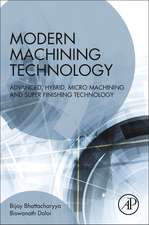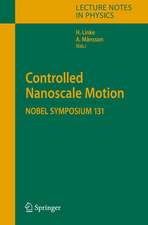Applied Scanning Probe Methods XII: Characterization: NanoScience and Technology
Editat de Bharat Bhushan, Harald Fuchsen Limba Engleză Paperback – 22 noi 2010
| Toate formatele și edițiile | Preț | Express |
|---|---|---|
| Paperback (1) | 575.06 lei 38-44 zile | |
| Springer Berlin, Heidelberg – 22 noi 2010 | 575.06 lei 38-44 zile | |
| Hardback (1) | 779.87 lei 38-44 zile | |
| Springer Berlin, Heidelberg – 4 noi 2008 | 779.87 lei 38-44 zile |
Din seria NanoScience and Technology
- 24%
 Preț: 905.79 lei
Preț: 905.79 lei - 18%
 Preț: 1123.35 lei
Preț: 1123.35 lei - 18%
 Preț: 964.71 lei
Preț: 964.71 lei - 18%
 Preț: 1121.76 lei
Preț: 1121.76 lei - 15%
 Preț: 655.60 lei
Preț: 655.60 lei - 18%
 Preț: 1390.11 lei
Preț: 1390.11 lei - 18%
 Preț: 954.31 lei
Preț: 954.31 lei - 15%
 Preț: 645.79 lei
Preț: 645.79 lei - 18%
 Preț: 953.03 lei
Preț: 953.03 lei - 18%
 Preț: 945.79 lei
Preț: 945.79 lei - 15%
 Preț: 639.90 lei
Preț: 639.90 lei - 18%
 Preț: 1109.16 lei
Preț: 1109.16 lei - 23%
 Preț: 779.87 lei
Preț: 779.87 lei - 18%
 Preț: 944.99 lei
Preț: 944.99 lei - 18%
 Preț: 957.62 lei
Preț: 957.62 lei - 18%
 Preț: 971.01 lei
Preț: 971.01 lei - 18%
 Preț: 1232.26 lei
Preț: 1232.26 lei - 18%
 Preț: 960.30 lei
Preț: 960.30 lei - 15%
 Preț: 646.62 lei
Preț: 646.62 lei - 18%
 Preț: 1249.31 lei
Preț: 1249.31 lei - 15%
 Preț: 636.80 lei
Preț: 636.80 lei - 18%
 Preț: 1232.26 lei
Preț: 1232.26 lei - 24%
 Preț: 821.43 lei
Preț: 821.43 lei - 18%
 Preț: 948.92 lei
Preț: 948.92 lei - 24%
 Preț: 1827.89 lei
Preț: 1827.89 lei - 18%
 Preț: 951.91 lei
Preț: 951.91 lei - 24%
 Preț: 794.21 lei
Preț: 794.21 lei - 18%
 Preț: 953.03 lei
Preț: 953.03 lei - 23%
 Preț: 782.55 lei
Preț: 782.55 lei - 18%
 Preț: 952.57 lei
Preț: 952.57 lei - 18%
 Preț: 948.16 lei
Preț: 948.16 lei - 18%
 Preț: 954.93 lei
Preț: 954.93 lei - 24%
 Preț: 809.40 lei
Preț: 809.40 lei - 23%
 Preț: 781.25 lei
Preț: 781.25 lei - 18%
 Preț: 954.93 lei
Preț: 954.93 lei - 18%
 Preț: 1830.34 lei
Preț: 1830.34 lei - 15%
 Preț: 641.71 lei
Preț: 641.71 lei - 18%
 Preț: 1228.96 lei
Preț: 1228.96 lei - 18%
 Preț: 1120.37 lei
Preț: 1120.37 lei - 18%
 Preț: 956.81 lei
Preț: 956.81 lei - 15%
 Preț: 592.59 lei
Preț: 592.59 lei - 18%
 Preț: 953.65 lei
Preț: 953.65 lei - 18%
 Preț: 954.62 lei
Preț: 954.62 lei - 18%
 Preț: 955.25 lei
Preț: 955.25 lei - 18%
 Preț: 959.19 lei
Preț: 959.19 lei - 18%
 Preț: 953.35 lei
Preț: 953.35 lei - 18%
 Preț: 786.84 lei
Preț: 786.84 lei
Preț: 575.06 lei
Preț vechi: 746.83 lei
-23% Nou
Puncte Express: 863
Preț estimativ în valută:
110.05€ • 119.50$ • 92.44£
110.05€ • 119.50$ • 92.44£
Carte tipărită la comandă
Livrare economică 19-25 aprilie
Preluare comenzi: 021 569.72.76
Specificații
ISBN-13: 9783642098703
ISBN-10: 3642098703
Pagini: 280
Ilustrații: LV, 224 p.
Dimensiuni: 155 x 235 x 15 mm
Ediția:Softcover reprint of hardcover 1st ed. 2009
Editura: Springer Berlin, Heidelberg
Colecția Springer
Seria NanoScience and Technology
Locul publicării:Berlin, Heidelberg, Germany
ISBN-10: 3642098703
Pagini: 280
Ilustrații: LV, 224 p.
Dimensiuni: 155 x 235 x 15 mm
Ediția:Softcover reprint of hardcover 1st ed. 2009
Editura: Springer Berlin, Heidelberg
Colecția Springer
Seria NanoScience and Technology
Locul publicării:Berlin, Heidelberg, Germany
Public țintă
Professional/practitionerCuprins
Direct Force Measurements of Receptor–Ligand Interactions on Living Cells.- Imaging Chemical Groups and Molecular Recognition Sites on Live Cells Using AFM.- Applications of Scanning Near-Field Optical Microscopy in Life Science.- Adhesion and Friction Properties of Polymers at Nanoscale: Investigation by AFM.- Mechanical Characterization of Materials by Micro-Indentation and AFM Scanning.- Mechanical Properties of Metallic Nanocontacts.- Dynamic AFM in Liquids: Viscous Damping and Applications to the Study of Confined Liquids.- Microtensile Tests Using In Situ Atomic Force Microscopy.- Scanning Tunneling Microscopy of the Si(111)-7×7 Surface and Adsorbed Ge Nanostructures.
Recenzii
From the reviews:
"Vol. XII contains nine contributions … of SPM applications on a variety of systems including biological systems for the measurement of receptor-ligand interaction, the imaging of chemical groups on living cells, and the imaging of chemical groups on live cells. These biological applications are complemented by nearfield optical microscopy in life science … . Each chapter … will make profitable reading for researchers at all experience levels. … All the chapters are … beautifully illustrated and in color too, also along with graphs, equations etc." (Current Engineering Practice, 2009)
“The articles … are written in sufficient detail, so that university students, researchers and engineers can understand the physics of the instruments, the design and construction of the devices and the cantilevers, the signal processing algorithms, and their use in imaging and the surface characterization of the specimens. … highlight various studies, techniques and applications that permit us to image, modify, fabricate and control structures at the molecular and atomic level. … well-written and clearly illustrated.” (Barry R. Masters, Optics & Photonics News, September, 2009)
"Vol. XII contains nine contributions … of SPM applications on a variety of systems including biological systems for the measurement of receptor-ligand interaction, the imaging of chemical groups on living cells, and the imaging of chemical groups on live cells. These biological applications are complemented by nearfield optical microscopy in life science … . Each chapter … will make profitable reading for researchers at all experience levels. … All the chapters are … beautifully illustrated and in color too, also along with graphs, equations etc." (Current Engineering Practice, 2009)
“The articles … are written in sufficient detail, so that university students, researchers and engineers can understand the physics of the instruments, the design and construction of the devices and the cantilevers, the signal processing algorithms, and their use in imaging and the surface characterization of the specimens. … highlight various studies, techniques and applications that permit us to image, modify, fabricate and control structures at the molecular and atomic level. … well-written and clearly illustrated.” (Barry R. Masters, Optics & Photonics News, September, 2009)
Caracteristici
First book summarizing the state of the art of this technique Real industrial applications included Includes supplementary material: sn.pub/extras





















